2012 VOLKSWAGEN GOLF PLUS weight
[x] Cancel search: weightPage 144 of 541

Never exceed tJ1e ve hicle's g ross veh icle
we ig h t ra lingorgross axle weight
ti on Label lo ca te d on the doo r pilla r of th e dri ver door. E xceeding th e permi ssible w eight can cause the ve hicl e to s kid and behave
A lw ays ad apt your sp ee d and driv in g style to
accommodat e your payload and its we ight t rib uli on with in yo ur ve hicle.
ally and gen tly and av oid sudden
Note ------------------~ Th e de fogge r heating w ires or antenna in the rear w ind ow can be damage d b y item s in the s tora ge
a rea rubbin g against th em .
The ve ntilatio n slo ts be twee n rear window and the lu ggage compartm ent cover must be k e pt free of obstru ctio n so that stal e air can escape from the vehicle.
Folding the backrest of the rear seat forward and back into place
Fig. 86 Rear seat: release
first r ead and no te th e introductory inf orm ation and heed the on page 142.
The rear back res t is divid ed into two sections. Each
sectio n of th e rear backres t can b e folded d own d iv idu ally to in crease the lu ggage sp ace.
Fo ldin g th e re a r back res t forward
the head restrai nt all the down p age 56.
66 while fo ld in g th e rea r bac krest forwa rd.
Th e rear backre st i s unlocked if the re d ma rk
ca n be see n on the bu llon
the rea r back rest is folded dow n, no one , cluding childre n, may rid e o n th e rear seat.
Transporting
Fo ldi ng the rear back rest back int o place
Fold the rear backrest b ack until it en g ages
The red mark on the release ®should
n o lo nge r b e v is ib le.
The rear backre st m ust b e sec urely lat ched into
p lace i n order for th e s afe ty be lt s o n th e rear seats
to provide optimal pro tection.
Never fold th e re a r b ackrest u p o r dow n w hile
th e ve hicle is m ov ing.
W hen f oldin g th e rear b ackrest back up,
m ake sure that the safety belt does not ge t
ca ught or d am age d.
Keep h an ds, fingers , fee t a n d other b ody parts o ut of th e rest up an d down.
move fonvard gether w ith th e rear b ackres t in the eve nt of
s u d de n
Page 152 of 541

Securing a
first r ead and note the introdu ctory information and heed the on pag e 149.
It is no t pos sibl e secure a load unless the roof rack sys te m has bee n pro perly
Maximum permissible roof load
Th e ma ximum permi ssibl e roof load is l65lb s. (75 kg). Th e roof load is the combined weight of
the roo f ra ck and the item s bein g carri ed on th e
Transporting
Checking the mountings
Afte r the base carrier and rook rack have been in
s talled, check all bolt s and faste n ers after drivin g a
s h ort time and at regular int erva ls th ereaft er.
If the maximum permissible roof load is ex
ceeded, accidents and substantial vehicle damage may occur.
Never exceed the specified roof load, the maximum gross axle weight rating, or the gross
veh icle weight rating .
Always make sure that loads are evenly dis
tributed and that heavier it ems are, as far as pos
sible, toward the front.
Loose
or improperly secured item s can fall off the roof rack and cause accid ents and injuri es.
Always use suitabl e, undamaged tie-down
ropes and ratchet straps.
the load
151
Page 153 of 541

In thi s section lowing:
Techni cal requirem ents ..... ............•. . . . 153
Hitching up and connecting a trailer . . . . . . . . . . . 154
Loading the traile r . . . . . . . . . . . . . . . . . . . . . . . . . . 155
Dri ving with a trailer . . . . . . . . . . . . . . . . . . . . . . . . 156
mo unt . . . . . . . . . . . . . . . . . . . . . . . . . . . . . . . . 157
Retrofitting a traile r hitch . . . . . . . .
country -s pecifi c requir em elll s about trailer
towin g and trai ler hit ches.
Your Volkswage n was mainl y designed f o r ca rryin g
passen gers. If yo u plan to tow a trail er, ple ase member your ve hicl e will be perfo rming job for
which it wa s no t primarily in tende d . Th e tion alload will aiTec t durabi lity, handling, fu el
economy, and p e rf ormance , and may re quir e th e
veh icle to be service d mo re ofte n.
T ra
iler towing only place s more str ess on th e
ve hicle , calls for more concentration from the
dri ver. Always follow the o p era ting and dri ving s tru ction s give n, and use common sense.
perm issible bar load
exerted on th e ball moulll should not exceed
More informati on:
ala rm pag e 38
page
Sav ing fuel and h elpin g th e en vir onment 198
S tarti ng ass istanc e page
T ires and page 276
acc essories, repairs and modifica tion s
Riding in a trailer is dangerou s and may be legal.
Before driving
Improper use o f the trailer hitch ca n cause
correct, or damaged trailer hitch ca n cause the
trailer to separate from the towing ve hicl e and cause se rious personal injuri es.
use an undamaged , properly mounted trailer hitch.
Never repair or modify the trailer hitch.
To reduce the risk of injury in rear-end sio ns and th e risk to pedestrians and cyclists when the vehicle is parked, always remove the ball mount when a trailer is not being used.
Neve r in stall a or hitch on you r ve hicle. The hicle was not design ed for these kind s of trailer
hit ch es. The hitch attachment can fail , ca using
th e trailer to tear loose from
Improper trailer towin g can cause loss of vehicle
co ntrol and serio us personal injury.
Driving with a trailer and carry ing heavy
o r large things can change th e way the vehicl e handles, increase the distance it need s to sto p
safely, and ca use accidents.
Always secure the load properl y with suitable and und amaged straps so that th e load will not
s hift .
Alw ays adapt your sp ee d and driv in g to
th e heav ier load and weight distribution in the vehicle. Take road, weather, traffic, and
Reduce your s pe ed even more th an yo u otherw is e would when going downhill and und er
unfavorabl e lo ad, weather, or wind co ndition s.
a lo w center of grav ity.
Always avo id sudd en maneu vers and hard
Be especiall y caref ul when pas sin g other ve hicl es. Reduce sp eed immediately if the traile r
shows the slightest sig n of swaying.
Page 156 of 541
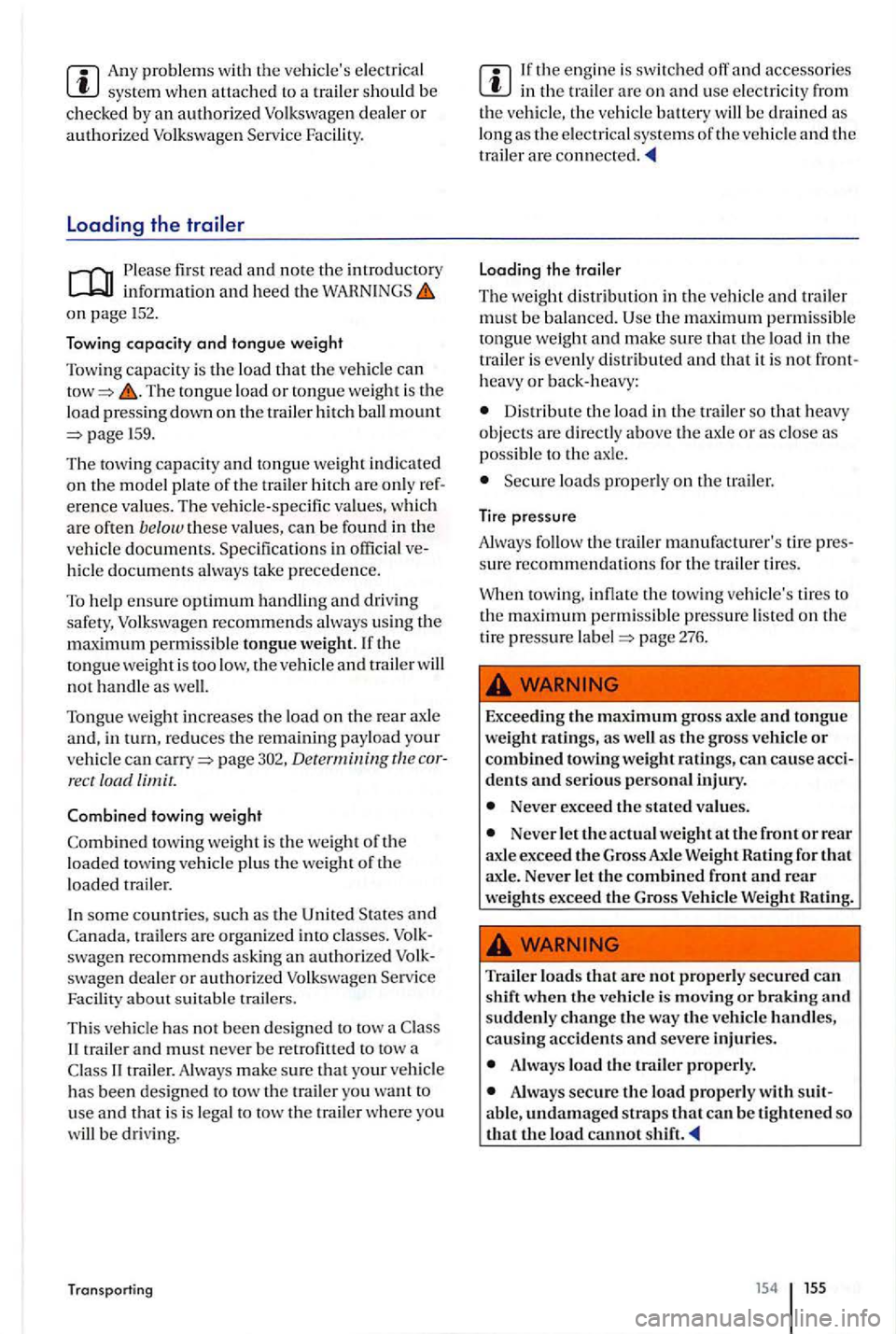
Any problems with the vehicle's elec trica l system when attached to a trailer should be chec ked by an authorized Volkswagen dealer or authorized Volkswagen Service Facility.
Loading the trailer
Pleas e first read and note the introductory information and heed the on page 152.
Towing capacity and tongue weight
Towing capac ity is the load that th e vehicle can
159.
The towing capacity and tongue weigh t indicated on the model plate o f the trail er hit ch are only re f
e ren ce value s. The vehicle-specific values, which are often below these values, can be found in the vehicle document s. Specificat ions in officia l ve
hicl e documents alwa ys take precedence.
To help en sure optimum handling and driving safe ty, Volkswagen recommends always using the
not handle as well.
Tongue weight increases the load on the rear axle and, in turn, reduces the remaining pay load your ve hicl e can cor
rect load limit.
Combined towing weight
towing weight is th e we ight of the
l oaded tow in g vehicle plus th e we igh t of th e
l oaded trailer.
In some countries, su ch a s th e States and Ca nada, trailer s are organ ize d in to cla sses. swagen recommend s askin g an authori zed swage n dealer or auth orized Volksw agen Se rvice
Facili ty about suitabl e trailer s.
Thi s
vehicle has not been desig n ed to tow a traile r and must n eve r be retrofitted to tow a II trailer. Always make sure that your vehicl e has been designed to tow the trai le r you want to use and that is is legal to tow the traile r where you be driving.
T ronsporting
Loading the trailer
The weig ht dist ribution in the vehicle and tra iler
mu st be balanced. th e maximum permissible
tongue weight and make sure that the load in the
trail er i s eve nly di stributed and that it is not front
h eavy or back-heavy:
Distribut e th e load in th e trail er so that heavy objec ts are directly above the axl e or as close as
po ssibl e to the
Secu re load s properly on the trail er.
Tire pressure
Always follow th e trail er manufac turer' s tir e pres
s ure recommendations fo r the trailer tires.
W h
en towing, inflat e th e towin g vehicl e's tir es to the maximum permissible press ure listed on th e
tir e pressure la bel pag e 276.
Exceeding
the maximum gross axle and tongue weight ratings, as well as the gross vehicle or combined towing weight ratings, can cause accidents and serious personal injury.
Never exceed the stated va lues.
Never let the actual weight at the front or rear axle exceed the Gross Axle Weight Rating for that
axle. Never let the combined front and rear weights exceed the Gross Vehicle Weight Rating.
Trailer loads
that are not properl y secured can shift when the vehicl e is moving or braking and suddenly change the way the vehicle handles,
causing accidents and severe injuries.
Always load the trailer properly.
Always secure the load properly with suitable, undamaged straps that can be tightened so that th e load cannot shift.
154 155
Page 157 of 541
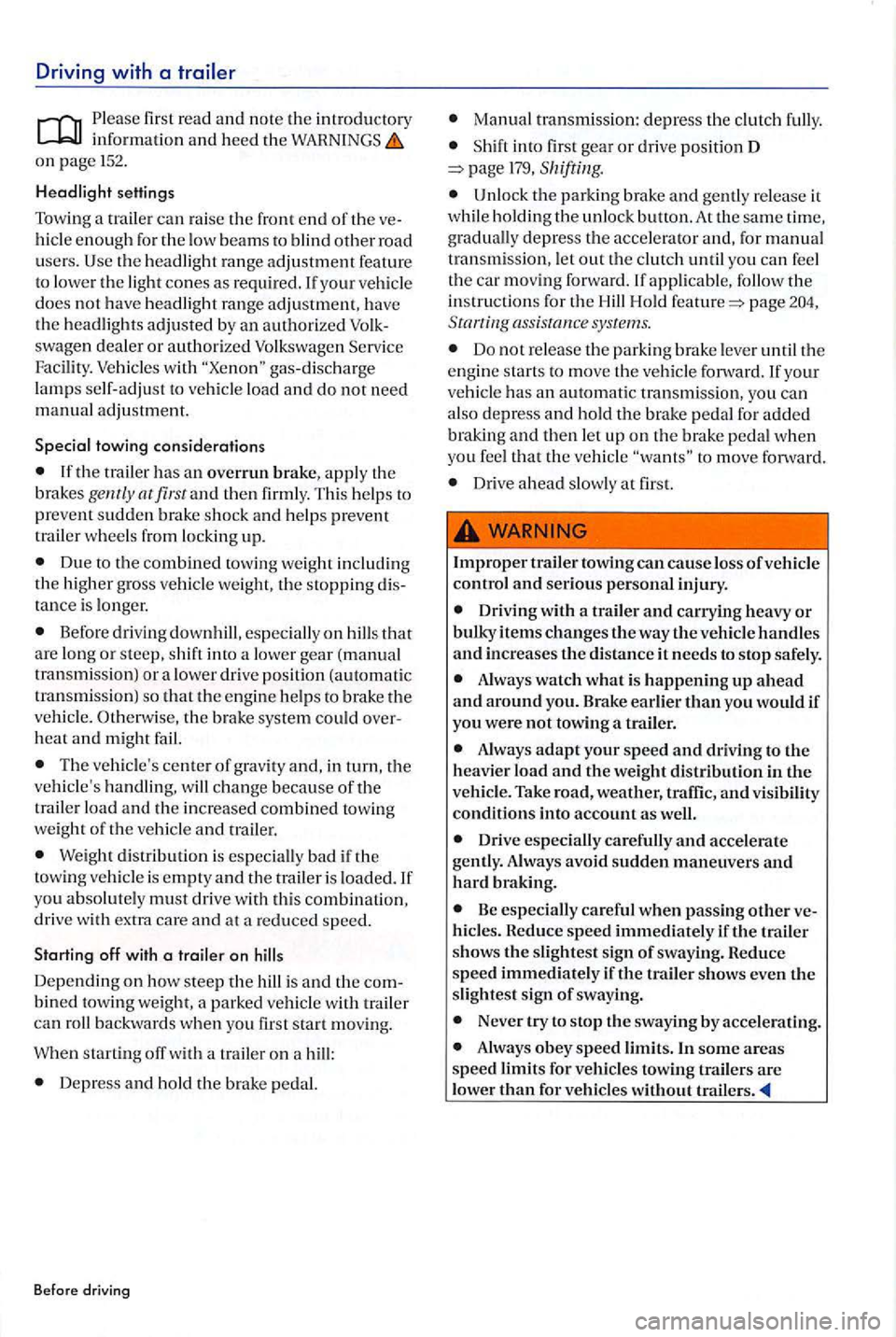
Driving with a
Please fir st read and note the introductory
o n page 152.
Headlight settings
Towing a tra
ile r can ra ise the fron t end of th e ve
hicle enough fo r the low beam s to blind other road u sers. the headlight ra nge adjustment feature
to lower the light cones as req uired . your vehicle does not have headlight range adjustment, have
the headli gh ts adjusted by an authorized Volkswage n dealer or au th orized Volkswagen Serv ice Facility . Vehicles with gas-d ischa rge lamps self-adjus t to vehicle load an d do not need manual adjustme nt.
Special towing
considerations
Due to th e combined towing weig h t includin g the hi gh er gross vehicle weight, the stopping distance is longer .
Before driving downhill , especially on hills that
a re long or steep, shift in to a lower gea r (m anual
t ransmi ssion) or a lower drive position (automatic
t ra n smi ssion) so that the eng in e helps to brake th e vehicl e. Otherwise, the b rake system could ove rheat and might fail.
The ve hicle's center of grav ity and, i n
Weigh t dis tr ibutio n i s especially bad if the
tow ing veh icle is e mpty and the traile r i s loaded. If
you absolutely must d rive with this combination , drive with extra care an d at a reduced speed.
Starting off with a trail er on hills
Depend ing o n how steep the h ill is and the combined tow ing weig ht, a parked vehicle wi th trailer can roll backwards when yo u firs t sta rt mov ing.
When sta rti
ng off with a trailer on a hill :
Depress and ho ld the brake pedal.
Befo re driv ing
Ma nual transmiss io n : d epress th e clutch fully.
Shift into fir s t gear or drive posi t ion D page 179,
Unlock the par ki ng brake and release it
w hil e ho ld ing th e unl ock butto n.
page assistance systems.
Do not re lease th e parkin g bra ke leve r until the engine sta rt s to move th e vehicle fonvard. your veh icle has an automatic t ransmissio n, yo u can
also depress a nd ho ld the brake pedal for added b raking and then letup on th e brake pedal w hen
you feel th a t the vehicle to move fo rward.
Drive ahead slowly at first.
A lways watch what i s happening up a head
and a round you. Brake earlier than you would if yo u were not to wing a trailer.
Drive especially care full y and accel erate gently. Always avoid sudde n m an euvers and h ard braking.
Be especiall y care ful when p ass ing other hicles. Reduce speed immediate ly if t he trailer
s hows the s lightes t sig n of swayin g. Reduce speed immediatel y if the t ra ile r shows even the
slightest sig n of sway ing.
Neve r try to sto p th e swayin g by accelerating.
Page 160 of 541
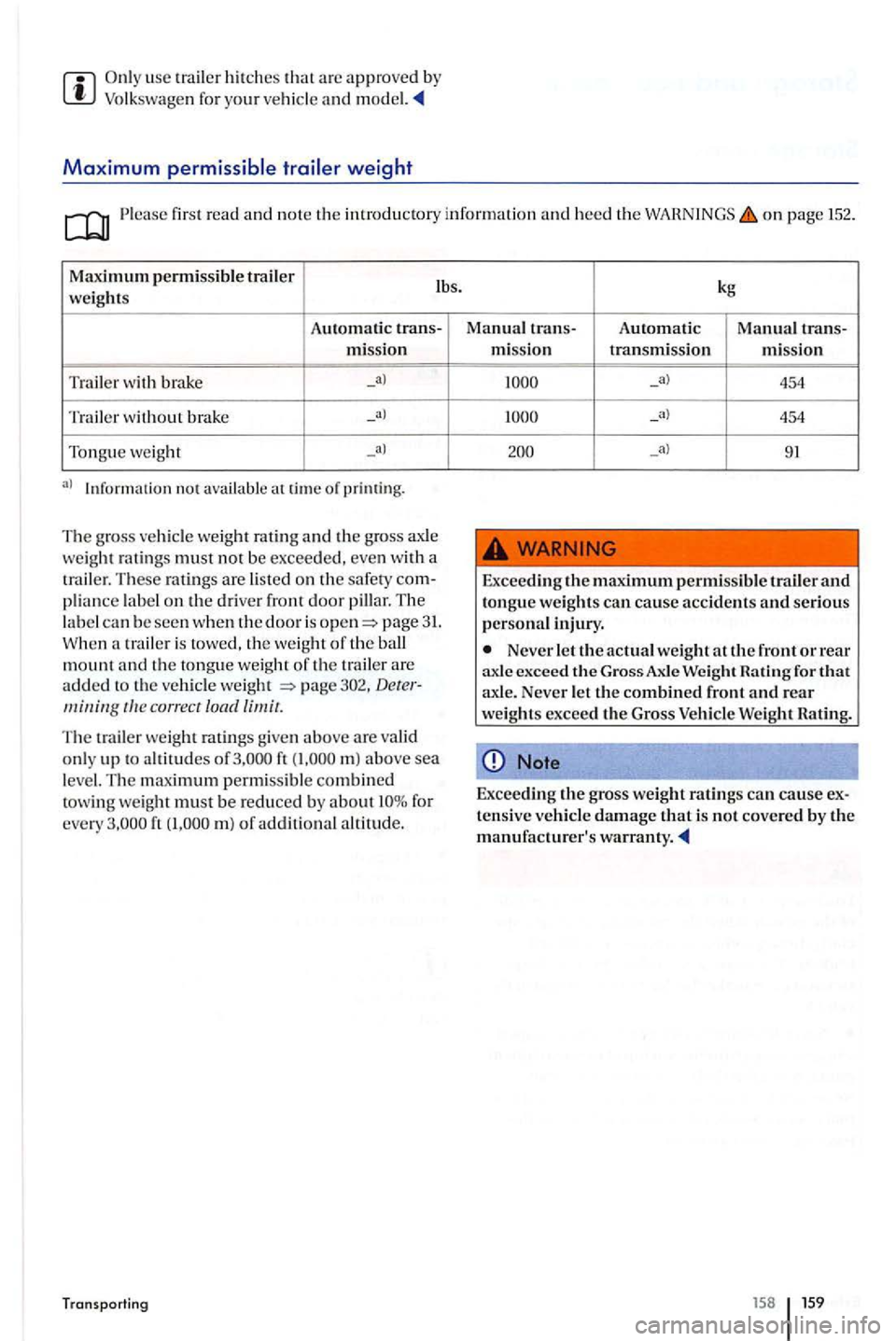
use trailer hitches that are approved b y Volkswage n for your ve hicl e and
Maximum weigh t
first read and note th e introductory informat io n and heed the on page 152.
Maximum permissibl e trailer
lbs.
weights
Automatic trans-mission
Trailer with _a)
Trailer with out brak e -
Tongue weight _a)
lnfonnation not a vailabl e at tim e of printing.
The gross ve hicle weight ratin g and the gross axle
we ight
pliance label on th e d rive r fr ont door pill ar. The
label can be seen when the door i s traile r is towe d, th e we ight of the ball mount and th e to ng ue we ight of the trail er are
ad ded to th e ve hicle weigh t
The trailer we ight
for
eve ry m ) of additi onal alt itu de.
T ransporting k
g
Manual trans-Automatic Manual trans-missio n transmission m ission
_a) 454
_a)
Exceeding the maximum permissi ble trailer and tongue we ight s can cause accidents and seriou s personal injury.
Never le t the actual weight at the front or rear forthat axle. Never le t the combined fr ont and rear
weight s exceed the Gross Vehicle Weight Rating.
Note
Exceeding the gross weight ratin gs can cause tensive ve h icl e damage that i s not co ve re d b y the manufacturer's
158 159
Page 201 of 541
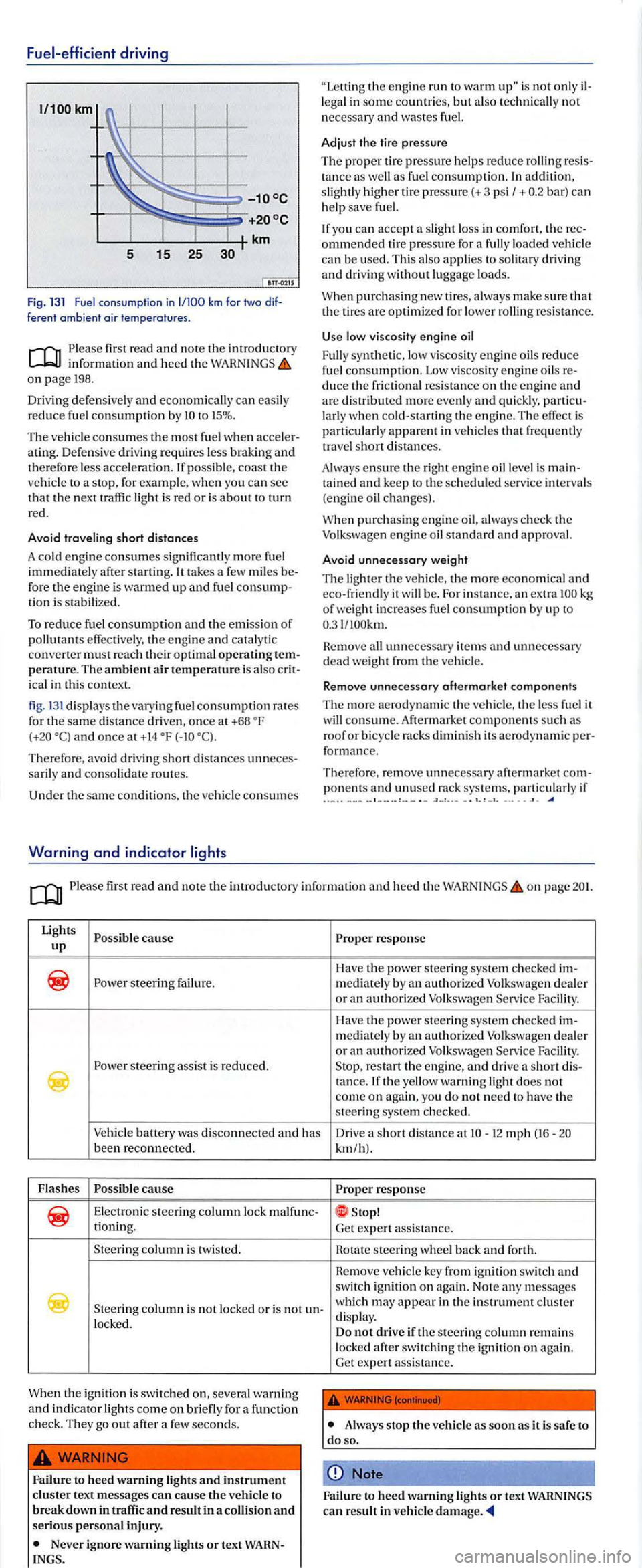
Fuel-efficient driving
Fig. 131 Fuel consumption in ferent ambient air temperatures .
info rmation and heed the on page 198.
Dri vin g defensive ly and economically can easily
r educe fuel con sumption by to 15 % .
The ve hicle consu mes the most fu el w he n atin g. D efe nsive dri vin g require s less brakin g and therefore less accelerat ion. If possib le, coast the ve hicle to a sto p, for exa mple, when yo u ca n see th a t th e next traffic ligh t is red or is about to turn
red.
Avoid traveling short distanc
es
A cold engine consumes sig nificantl y more fuel
imm ediately after sta rtin g. It take s a few miles fore the engi ne is warm ed up and fuel tion i s stabili zed.
To reduce fuel consumptio n and the emission of pollutants effect ive ly, the e ng in e and ca talytic
conve rter must reach th eir optimal operating
ica l in thi s context.
fig. 13 1 displays the v a ry ing fuel consumption rates
for the same d istance dri ven, once at +68 and once at + 14
th e e ngin e run to warm is not o nl y lega l in some co untries, but also technicall y not
n ecessary and wastes fu el.
Adjust the tire pres sure
T he prop er tir e
pressure help s reduce rollin g tance as well as fue l co nsumption. In additi on ,
slig htl y higher tire pressure(+ 3 psi I+ bar) ca n
h e lp save fuel.
If you ca n a ccept a slight los s in comfort, the ommend ed tir e pressure for a fully loade d ve hicl e
ca n be used. This als o applies to so litary dri vin g and driv ing withou t lu ggage loa ds.
When purchasing new t ires, alway s ma ke sure th at
th e tires are optimi zed for lower rollin g resis tance.
Us e low viscosity engine oil
F ull y sy nth e
tic, low viscosity e ngine oils reduce
fuel consumption. Low viscosity e ngin e oils duce the fric tional res istance on th e engine and are dis tributed m ore evenly and qui ckly, larly w hen co ld -s tarting the engine. The effect is parti c ularl y apparent in vehicles th at frequentl y
tra vel s hort dis tan ces.
A lways ens
ure th e righ t e n g in e oil leve l is ta in ed and keep to the sc h edul ed serv ice interva ls
(e ng ine oil ch an ges).
W
hen purch asing e ngine oil, always ch eck th e Volksw agen en gine oil standard and approval.
Avoid unnecessary weight
The lighter th e ve hicl e, th e more economica l and ceo-friend ly it w ill be. For in stance, an extra
H e m ove
consum e. Aftermark et co mponents s uch as
ro of or b icycle racks dimin is h its aerod yn a m ic fonnan ce.
Th erefo re, re
mov e un necessary aftermark e t ponents and unused rac k systems, parti cul arly if ....... -
fir st read and note th e introductory informa tion and h ee d th e WAHNINGS page
response
Ha ve the power stee rin g sys te m ch ec ked ste eri ng failure. mediatel y by an authori zed Volk swag en deale r
o r a n authorized Volk swagen
Fac ility. steeri ng ass is t i s reduced. re start the e n gine, and dri ve a sh ort tan ce. If th e yello w warning light does not
c o m e on again, you do not need to have th e
s te ering syste m ch ec ke d .
Vehicle battery was di sconnected and has Drive a short distan ce at 12 mph been reconnec te d . km/h).
F lashes re sponse
Elec troni c steering column lo ck malfunc -
which m ay appea r in the in strument clu ste r
di sp lay. loc ke d.
W
hen the i g nit ion is switc h ed on, seve ra l wa rnin g and indicator lights come on bri efly for a f un ction ch e ck . T hey go out after a few seconds.
Failure to
heed warning light s and in strument cluster text m essages can cause th e vehicl e to break down in t raffic and result in a collisio n and seriou s personal injury.
Neve r igno re warning lights or tex t
Do not dri ve if th e s teerin g co lumn remains
l ocke d switch in g th e ig niti on on aga in.
Ge t expert assis ta nce.
Alwa ys sto p the vehicl e as soon as it is safe to do so .
Note
Failur e to heed warning lights or tex t WARNINGS can res ult in vehicl e damage
Page 213 of 541
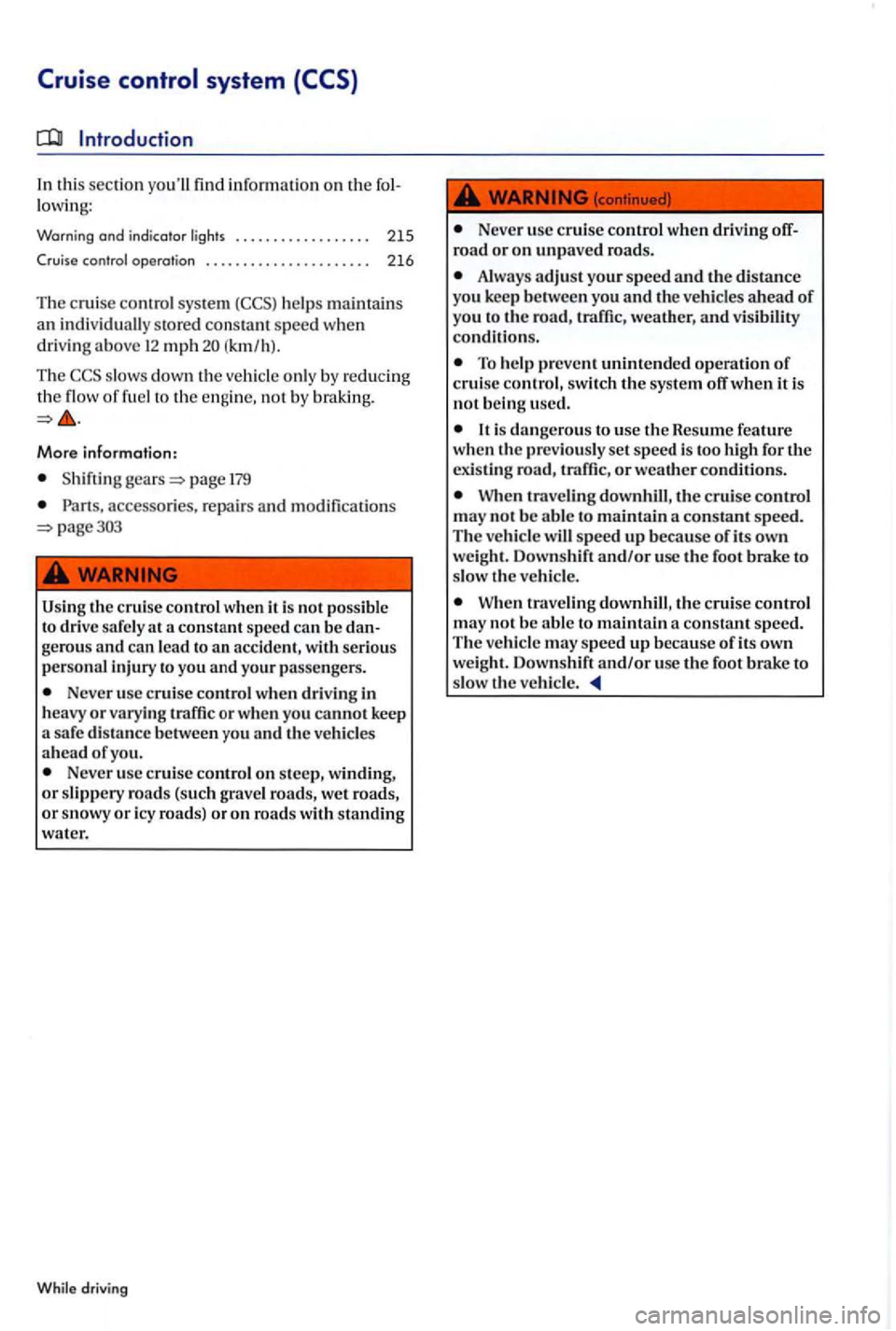
Introduction
th is section yo u'll fin d inform ation on the followi ng:
Warning ond indica tor lights . . . . . . . . . . . . . . . . . . 215
Cruise control operation . . . . . . . . . . . . . .
h elps maint ains
an indiv idually s tored con stan t sp ee d w hen
d ri vin g above 12 mph (km /h).
Th e
More information:
page 179
Parts, acce ssories. repa irs an d modificat io ns page 303
Using the cruise control when it is not possibl e
t o drive safely at a constant speed can b e dan
gerous
Never use cruise control when dri ving in
h eavy or varying traffic or when you cannot keep
a safe distance betwe en you and the ve hicle s ahead of you. Never use cruise contro l on ste ep , winding, or slippery roads (s uch grav el roads, wet roads, or sno\vy or icy road s) or on road s with standing
wat er.
Never use cruise control when driving off
road or on unpave d road s.
Always adjust your speed and the di stance yo u keep betwe en you and the vehicles ahead of you to the weather, and vis ibility condition s.
To he lp prevent unintended operation of crui se control , switch the s y stem off when it is not
It is dange rous to use the Resume feature
wh en th e prev iously set speed is too high for the exis ting traffic, or weather condi tion s.
When traveling downhill , tJ1e cru ise control may no t b e a ble to maintain a cons tant sp eed .
Th e vehicl e will spe ed up b ecause of it s o wn
weight. Downshift and/or usc the foot brake to
s low the ve hicle.
When travelin g downhill , the crui se control may not be able to a constant speed.
The vehicle may speed up b ecause of it s own
weight . Dow nshift and/or u se the foot brak e to
s lo w the vehicle.